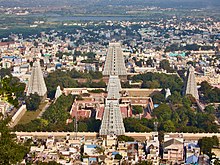| Arunachalesvara Temple | |
|---|---|
 View of the Arunachalesvara temple towers from the Arunachala hill | |
| Religion | |
| Affiliation | Hinduism |
| District | Tiruvannamalai district |
| Deity | Arunachalesvara (Shiva) Unnamalai (Parvati) |
| Festivals | Karthika Deepam |
| Features |
|
| Location | |
| Location | Thiruvannamalai |
| State | Tamil Nadu |
| Country | India |
| Geographic coordinates | 12°13′53.76″N 79°4′1.92″E / 12.2316000°N 79.0672000°E |
| Architecture | |
| Type | Dravidian architecture[1] |
| Creator | Cholas |
| Completed | 9th century CE |
| Website | |
| www.arunachaleswarartemple.tnhrce.in | |
Arunachalesvara Temple (also called Annamalaiyar Temple), is a Hindu temple dedicated to the god Shiva, located at the base of Arunachala hill in the town of Tiruvannamalai in Tamil Nadu, India. It is significant to the Hindu sect of Shaivism as one of the temples associated with the five elements, the Pancha Bhuta Sthalas, and specifically the element of fire, or Agni.
Shiva is worshiped as Arunachalesvara or Annamalaiyar, and is represented by the lingam, with his idol referred to as Agni lingam. His consort Parvati is depicted as Unnamalai Amman.[2][3] The presiding deity is revered in the 7th century CE Tamil Saiva canonical work, the Tevaram, written by Tamil saint poets known as the Nayanars and classified as Paadal Petra Sthalam. The 9th century CE Shaiva saint poet Manikkavacakar composed the Tiruvempavai here.
The temple complex covers 10 hectares, and is one of the largest in India.[4] It houses four gateway towers known as gopurams. The tallest is the eastern tower, with 11 stories and a height of 66 metres (217 ft), making it one of the tallest temple towers in India built by Sevappa Nayakar (Nayakar dynasty)[4] The temple has numerous shrines, with those of Arunachalesvara and Unnamalai being the most prominent. The temple complex houses many halls; the most notable is the thousand-pillared hall built during the Vijayanagara dynasty.
The present masonry structure was built during the Chola dynasty in the 9th century CE, while later expansions are attributed to Vijayanagara rulers of the Sangama Dynasty (1336–1485 CE), the Saluva Dynasty and the Tuluva Dynasty (1491–1570 CE). The temple is maintained and administered by the Hindu Religious and Charitable Endowments Department of the Government of Tamil Nadu.
The temple has six daily rituals at various times from 5:30 a.m. to 10:00 p.m., and twelve yearly festivals on its calendar. The Karthika Deepam festival is celebrated during the day of the full moon between November and December, and a huge beacon is lit atop the hill. It can be seen from miles around, and symbolizes the Shiva lingam of fire joining the sky.[5] The event is witnessed by three million pilgrims. On the day preceding each full moon, pilgrims circumnavigate the temple base and the Arunachala hills in a worship called Girivalam, a practice carried out by one million pilgrims yearly.[4][5][6]
- ^ Melton, J. Gordon (2014). Faiths Across Time: 5,000 Years of Religious History [4 Volumes]: 5,000 Years of Religious History. ABC-CLIO. p. 610. ISBN 9781610690263. Retrieved 26 February 2019.
- ^ Singh et al. 2009, p. 418.
- ^ Abram et al. 2011, p. 456.
- ^ a b c Bajwa & Kaur 2008, p. 1069.
- ^ a b Bradnock & Bradnock 2009, pp. 827–828.
- ^ Tiruvannamalai - Places of interest 2011.

